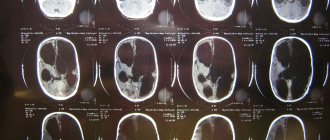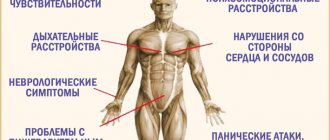Types of auditory illusions
Auditory hallucinations are:
- True - a person, seeing such illusions, is sure that they exist in reality. Such extraneous noises make it difficult to fall asleep.
- False - noise inside the head or other parts of the body. Such illusions are considered the most dangerous for a sick person. Pseudohallucinations do not depend on a person’s will and are characterized by obsession, violence and completeness.
- Imperative - sharp exclamations giving orders can be dangerous both for the person himself and for his environment.
- Threatening - a type of illusion in a dream, when the patient can hear threats to himself and his loved ones.
- Contrasting (antagonistic) - a dialogue inside the head, a kind of dispute between two sides.
- Tactile - expressed in non-existent touches. The patient describes the condition as follows: “I wake up because insects are crawling on my skin.”
- Suggested - deception of feelings, for example, under the influence of hypnosis.
- Functional hallucinations are the presence of a stimulus that affects the senses.
Diagnostics
Constant illusions are not a disease - they are only a symptom of an incipient disease.
First of all, the doctor communicates with the patient and receives a description of what is happening from him. Depending on the patient’s condition, difficulties may already arise at this stage in providing the necessary information. If it is not possible to obtain information from the patient, the doctor can interview relatives.
A number of tests are required, such as urine, blood, and spinal cord examinations. If the patient uses a hearing aid, it will need to be checked for malfunctions.
A person’s behavior may give reason to suspect the presence of acoustic hallucinations. For example, if the patient does not immediately answer the questions that are asked to him, or seems to be listening to something. An important factor in obtaining information from the patient will be the establishment of correct contact, in which a trusting relationship can arise between the doctor and the patient.
Often hallucinations when falling asleep are observed in women and adolescents. As they grow older, they visit people less and less often. The only exceptions are those cases when they are caused by health problems.
Therapy methods
Taking medications selected by a doctor, if the patient has hallucinatory disorders, will most likely be permanent. Treatment is selected only by a doctor and individually for each patient.
The doctor may prescribe antipsychotic drugs for continuous use. For patients whose symptoms appear as a result of taking medications, the dose used is adjusted. After repeated examination, it is possible to use analogue drugs.
A fairly common problem caused by hallucinations is tinnitus, the occurrence of sounds of unknown origin that do not exist in reality. It should be noted that such phenomena are not as harmless as is sometimes believed. Constant or periodic sounds can represent symptoms of disorders, and sometimes quite serious ones. In patients with auditory hallucinations, noise manifests itself in different ways. In the mild form of the disease, the phenomenon is especially pronounced in silence; in other situations, the sounds present in the environment cover up the hallucinations. Patients often complain that strange sounds arise at the moment when a person changes body position or makes certain movements.
Sometimes, upon additional examination, it turns out that this condition is associated with changes in pressure in the blood vessels, muscles, and nerves. As a rule, patients usually say that sound hallucinations can be compared to a low-frequency whistle, or the person hears hissing, buzzing, creaking, and other sounds. Moreover, low-frequency noises are observed less frequently during auditory hallucinations. Such noise is often mistaken for the sounds produced by operating ventilation or other household electrical appliances. If you hear noise, but are not sure that it comes from an external source, you should clarify this circumstance with those around you.
Another type of sound hallucinations are various sounds that can be classified as musical. Such phenomena are typical for people with partial hearing loss; in patients with normal hearing they are quite rare, and if they are observed, they quickly pass. Sound hallucinations called pulsating are also known. Their peculiarity is that the patient hears rhythmic sounds that sound in time with the heart. In most cases, they are caused by changes in blood flow in the vessels that are located near the ears. Such hallucinations are very annoying for the patient, and can lead to an extremely agitated state when immediate medical attention is required.
Causes of auditory hallucinations
When auditory hallucinations occur, one of the common causes of the disease is a damaged inner ear. In this case, the sounds that a person hears fall into it, then, using the auditory nerves, information about the existing sounds is transmitted to the brain. If there is any damage to the inner ear, information access to certain parts of the brain may be impaired. Thus, these areas begin to persistently “demand” the missing information from parts of the inner ear that continue to function normally. But under such conditions, their signals are distorted, creating auditory hallucinations.
If such a disorder occurs in elderly patients, then sound hallucinations may accompany the aging process, during which hearing becomes worse. Young people often suffer from inner ear damage caused by regular exposure to excessive noise. Also, many diseases can be among the causes that damage the inner ear and lead to sound hallucinations. For example, middle ear infections, otosclerosis, Meniere's disease, anemia, Paget's disease. It happens that sound hallucinations are caused by the accumulation of earwax, which has a blocking effect on the ears.
Rarer causes of tinnitus and non-existent sounds include traumatic brain injury, a consequence of exposure to unexpected and excessively loud noise, such as an explosion or gunshot. In some cases, auditory hallucinations are caused by an acoustic neuroma, a rare benign tumor that affects the auditory nerve. In clinical practice, there are cases where auditory hallucinations are side effects caused by an overdose of certain medications. People who abuse drugs or suffer from alcoholism are also at risk and often experience various types of auditory hallucinations.
Treatment of auditory hallucinations
Audible hallucinations are a very good reason to seek help from a specialist. Do not forget that this condition is a clear danger, since it may turn out that these are symptoms of diseases that require immediate treatment. To identify the cause of noise and strange sounds in the ears, a special hearing test is used, the functioning of the vestibular apparatus is assessed, and an X-ray of the ears and a blood test are also performed. Sometimes the doctor prescribes magnetic resonance imaging or computed tomography.
When treating sound hallucinations, the therapeutic effect is on the immediate disease that needs to be cured to get rid of tinnitus and eliminate sounds that do not exist in reality. Sometimes the treatment is simple and the patient only needs special drops. In some cases, your doctor will prescribe procedures to remove earwax. But, of course, such simple cases, unfortunately, are rare, and sound hallucinations cannot be easily cured. In addition, there are no drugs that can quickly eliminate the symptom.
Hallucinations are imaginary, objectless perceptions and sensations that arise without any stimuli. This is a deception, an error in perception by the senses. Having succumbed to it, a person sees, senses, feels and hears what is not really there. They vary in type, and are tasteful, bodily, visual and auditory. Today we will focus only on auditory ones, and talk about them in more detail.
What are auditory hallucinations, how and in what cases do they manifest themselves?
Auditory (imperative) hallucinations are characterized by deceptive sensations when a person hears someone’s speech, individual words, calls and voices that do not exist in reality. These imaginary voices give orders, scold, calm, praise.
Probably every person has talked to himself at least once in his life. Well, for example, when you suddenly lose something, you can say out loud: “Why am I so absent-minded.” This is absolutely normal. But when someone else’s voice inside your head suddenly confirms: “yes, you are a terrible mess,” you will agree, you will immediately think about a visit to a psychiatrist.
Indeed, when a person hears such non-existent things, he may well have a mental disorder or neuralgic disease. In such cases, you must definitely contact a specialist and start treatment on time to avoid worsening the condition.
Among specialists in the field of psychiatry, there is an opinion that auditory hallucinations are a person’s own thoughts, the “voice of the subconscious,” which are expressed in the form of words. When they take on verbal form, they are not perceived by a person as their own thoughts, but are perceived as the voice of an outsider, an unfamiliar person or creature.
People suffering from serious mental illness perceive such voices as real. Therefore, they confidently declare their reality. And if the voice they hear ordered them to kill themselves, or another person, they would certainly do it. Patients believe the voices unconditionally and do not understand that they are simply a deception of the psyche.
Most often, such disorders occur in schizophrenia, which is a serious mental illness that mainly affects young and middle-aged people.
In addition, similar hearing disorders may be present in those suffering from various manias. They occur in Alzheimer's disease and long-term, severe depression. They can be triggered by alcoholism, binge drinking, or simply drinking large amounts of alcohol. Also, false perception of hearing can occur due to the use of a low-quality hearing aid.
Separately, it is necessary to say about depression. Quite a lot of people who suffered from depressive conditions at certain points in their lives periodically heard voices calling them by name. This phenomenon has not yet been fully studied by doctors. But they believe that these phenomena in this case are not a symptom of mental illness.
What to do?
First of all, as soon as “voices” appear, you need to go to a therapist for help. After an examination and conversation, the doctor will decide whether you need to see a psychiatrist or not. If such sensations are caused by a mental disorder, the psychiatrist will prescribe treatment with psychotropic drugs and antidepressants. If therapeutic treatment is possible, the doctor will prescribe relatively simple medications to eliminate hearing deception.
We must not forget that such phenomena can occur due to the use of certain medications, especially those prescribed against spasms. If you suspect this reason, make a list of all the medications the patient is taking and show it to the doctor. Thus, it will be possible to find out which particular medicine, or a combination of several, causes such a side effect.
If you have a hearing aid, you should definitely have it tested. Since its malfunction quite often becomes the cause of auditory hallucinations.
How to cure?
Treatment of any hallucinations, including auditory ones, is carried out strictly individually, since the reason for such a deviation is different for everyone and depends on many factors. In this regard, the first thing the doctor must do is to establish the cause of the pathological manifestations.
If necessary, the doctor prescribes psychotropic medications and antidepressants. However, more often than not, simpler medications are sufficient. The doctor will also prescribe them, based on the patient’s condition and the cause of the hallucinations.
Even if it is caused by taking medications, such as anticonvulsants, it is enough to replace one drug with another and the hallucinations will disappear.
If obsessive sensations are associated with a malfunction of the hearing aid, which happens quite often, you should contact a specialist - an audiologist and have the device tested.
Auditory deception usually occurs in silence, when a person is alone and not distracted by anything. The danger is that often patients cannot resist the orders that the “voices” give them, and the person can commit irreparable acts. That is why you should not take this condition lightly, but should promptly contact a specialist for help. Be healthy!
Auditory hallucination
- a form of hallucination when the perception of sounds occurs without auditory stimulation. There is a common form of auditory hallucination in which a person hears one or more voices. This may be associated with psychotic disorders, but voices can also be heard by people who do not have a diagnosable mental illness.
Clinical manifestations
Hallucinations at night or during the day occur as a reaction to disruption of the analyzers and brain association centers. Hallucinations that occur while asleep are false perceptions. Sound stimuli appear without a real external source. Patients are unable to distinguish between real and imagined sound phenomena.
The patient, at the request of the doctor, can repeat the words and phrases that the voice says, and can show exactly where the sounds are coming from and where the person talking to him is. Patients distinguish the timbre of a voice and can determine whether it belongs to a man or a woman, an adult or a child.
Projecting an imaginary sound stimulus into reality prevents the correction of the disorder and leads to a situation where the patient is firmly confident in the objectivity of his feelings and what is happening. The appearance of sound phenomena is always involuntary - the patient is not able to cause them on his own.
The patient cannot get rid of auditory hallucinations or control them, because they arise contrary to his will and desires. It is impossible to convince the patient that he is imagining voices and extraneous sounds that occur after waking up from sleep or at other times of the day. He is firmly convinced of their reality. Hallucinations before sleep often take the form of:
- The sound of the wind.
- The sound of the sea surf.
- Howl of animals.
- The buzzing of insects.
- Human speech.
Musical hallucinations appear in the form of previously heard or unfamiliar melodies, excerpts of works or individual musical phrases. Musical sound phenomena can be periodic or constant. The most common are verbal forms. In this case, elements of echolalia (uncontrolled repetition of words and phrases borrowed from someone else’s speech) and perseveration (sustained repetition of words and phrases) are often observed.
Verbal hallucinations when falling asleep are usually represented by the voices of people - familiar and unfamiliar. Voices can be single or group, sound nearby or from afar. The nature of sound stimuli varies significantly; they can be neutral, muffled, rhythmic, and random. It is not uncommon for the tone to be offensive, aggressive or coercive.
Voices often humiliate or blame the patient, pointing out mistakes he has made - real and imagined. Sometimes sound stimuli have a positive connotation. The patient can hear how he is presented with prizes and awards, appointed to a prestigious position, and assigned responsible, honorable tasks. For example, voices can provide advice, provide informational messages, or ask questions.
There are frequent cases of antagonistic forms of sound stimuli, when the content changes in the opposite direction, for example, at first it is threatening, then protective, or first contains an accusing, then justifying meaning. An example would be cases when a patient hears him being scolded in a harsh, rude manner, scolded, and then pitied and gently offered to improve. More often than not, different voices act as antagonists.
Verbal forms can be autonomous. In this case, the voice message is not directed to the patient. More often, voices enter into dialogue with the patient, ask him, answer questions, express an independent opinion, talk about themselves, plan the future. Sometimes messages are presented in the form of predictions, anticipations of events. For example, voices warn the patient that he will soon have a headache or want to sleep.
Patients often consider voices to be messengers of the other world. The most dangerous forms of auditory hallucinations are imperative (imperative, not tolerating objections), which are a kind of orders to the patient. Audio messages can be harmless when voices command patients to perform an action that does not pose a risk to the health of the patient or other people. Examples are orders to cook food, put on a certain item of clothing, go to some place (store, park), throw away money.
Auditory hallucinations when falling asleep are often associated with a threat to the health and life of people - the patient himself and those around him (acquaintances or strangers). Voices often order patients to commit suicide or murder, to cause bodily harm, or to burn clothes. These are the most dangerous forms of manifestation. Patients cannot resist orders; they often follow instructions unquestioningly.
Their behavior is determined by the voices in their heads that they hear before bed, when they fall asleep, or during the day. Often patients deny the presence of extraneous sound phenomena, but their demeanor gives them away. For example, during a visit to a psychiatrist, they may spontaneously say that someone should not disturb them because they are busy right now, but the nature of the relationship with the doctor does not imply such a reaction.
Types of auditory hallucinations
Simple auditory hallucinations
Acoasma
Non-speech hallucinations are characteristic. With this type of hallucination, a person hears individual sounds of noise, hissing, roaring, and buzzing. Often there are the most specific sounds associated with certain objects and phenomena: steps, knocks, creaking floorboards, and so on.
Phonemes
The simplest speech deceptions are typical in the form of shouts, individual syllables or fragments of words.
Complex auditory hallucinations
Hallucinations of musical content
With this type of hallucination, one can hear the playing of musical instruments, singing, choirs, known melodies or excerpts thereof, and even unfamiliar music.
Potential causes of musical hallucinations:
- metal-alcohol psychoses: often these are vulgar ditties, obscene songs, songs of drunken groups.
- epileptic psychosis: in epileptic psychosis, hallucinations of musical origin often look like the sound of an organ, sacred music, the ringing of church bells, the sounds of magical, “heavenly” music.
- schizophrenia.
Verbal (verbal) hallucinations
With verbal hallucinations, individual words, conversations, or phrases are heard. The content of statements may be absurd, devoid of any meaning, but most often verbal hallucinations express ideas and thoughts that are not indifferent to patients. S.S. Korsakov considered hallucinations of this kind as thoughts dressed in a bright sensory shell. V. A. Gilyarovsky pointed out that hallucinatory disorders are directly related to a person’s inner world, his state of mind. They express disturbances in mental activity, personal qualities, and the dynamics of the disease. In particular, in their structure one can detect disorders of other mental processes: thinking (for example, its fragmentation), will (echolalia), and so on.
There are a large number of types of verbal hallucinations, depending on their plot. Among them are:
- Commentary (evaluative) hallucinations. The opinion of voices about the patient's behavior is reflected. An opinion can have a different connotation: for example, benevolent or judgmental. “Voices” can characterize and evaluate current, past actions or intentions for the future.
- Threatening. Hallucinations can acquire a threatening character, consonant with delusional ideas of persecution. Imaginary threats of murder, torture, and discredit are perceived. Sometimes they have a clearly expressed sadistic overtones.
- Imperative hallucinations. A type of verbal hallucination that is socially dangerous. Contains orders to do something or prohibitions on actions, to commit actions that directly contradict conscious intentions: including attempting suicide or self-harm, refusing to take food, medicine or talking with a doctor, and so on. Patients often take these orders personally.
Hallucinations when falling asleep - causes, types, treatment
Hallucinations while falling asleep are a rare phenomenon called hypnagogic imagery. For the first time they started talking about such a phenomenon in the 16th century. An imaginary state at the moment of entering the first phase of sleep occurs in both children and adults, but often the impressions are not so strong that they are not remembered by the patient.
Types and features
On the border between wakefulness and sleep, various images arise. Depending on what the patient imagines and how he relates to what is visible, several types of hypnagogic imaginary illusions are distinguished.
- True. They are distinguished by the absence of a provoking factor. The pictures that appear cause anxiety and are perceived calmly and unemotionally. Hallucinations are a continuation of real phenomena or do not introduce fear.
- Pseudohallucinations have an alarming character. These visions are bright and realistic. The patient notes an obsessive desire to close or hide from emerging images. Unlike true ones, pseudohallucinations “capture” the brain, causing a feeling of fear, inevitability and blame. A striking example of pseudo-illusions are goosebumps or insects running all over the body and head, voices, screaming and tinnitus. It is important to note that all these visions are not realistic and occur in people with mental disorders that require inpatient treatment.
Another classification allows you to determine the type of unreal visions. The classification depends on which sense organ is involved in the process.
Visual hallucinations. The most common group of illusions before bedtime. In a borderline state, bright flashes and full-fledged plots are seen. Hypnagogic mirages can easily be mistaken for a “daydream.”
Tactile illusions. A group similar to visual visions, the difference lies in the clear sensation of touching the body, involving the sleeper himself in the plot. Children report a feeling of weightlessness or flight. Frequent phenomena of this nature are a reason to pay more attention to the younger generation.
Olfactory illusions. The process involves the ability to identify odors. With this pathology, a person notices obvious odors of excrement, rot or stale meat. In fact, the surrounding air does not contain “odorous” impurities, and this only seems to the patient. They are often combined with taste sensations, causing appetite or, conversely, a persistent aversion to any food derivatives.
Important! The appearance of taste sensations in the mouth at the beginning of sleep may indicate physiological disorders.
Functional sensations. Periodic twitching of the limbs, which can be felt in reality. Frequently occurring movements are combined with dreams, which suddenly occur in the first phase of sleep.
Vestibular sensations when falling asleep manifest themselves in the form of flight, rotation and any other movement, which can cause dizziness. Vestibular illusions are the third most common.
Visceral hypnagogic images are a pathological perception of reality, characteristic of persons with a disorder of the mental system. A person feels the presence of foreign objects, alien creatures or moving living parasites in the body.
Auditory hallucinations are a wide group of illusions before falling asleep, which are characterized by pathological and physiological causes. A clear example is the loss of a loved one, whose voice is heard in the first phase of dreams. The pathological nature of auditory illusions is inherent in people with mental development disorders. Auditory mirages are divided into 3 types:
- threaten a person, his family and close people, which causes fear, but not panic, so there are no active actions on the part of the patient;
- imperative or commanding - voices tell you to do something, which is one of the signs of acute schizophrenia;
- contrasting opposites: one part encourages the patient to act, the other stops.
It is important to note that urging or calling voices are a sign of a patient's illness that requires special treatment.
When and which doctor to contact
Hallucinations before falling asleep are an extremely rare occurrence. Often illusions are short-term and isolated. In this case, medical attention is not required. The grounds for medical intervention are:
- discomfort from mirages and subsequent attacks of fear;
- changes in behavior due to hallucinations before sleep;
- aggression and panic in the patient.
The doctor may prescribe a number of studies, one of which is the study of somnological parameters. The diagnosis and subsequent treatment of the disease is carried out by a somnologist. In case of obvious sleep disorders and excessively suspicious behavior of the patient, the help of a psychiatrist is necessary.
Prevention
Prevention plays a special role in the treatment of hypnagogic illusions. To exclude possible visions before a night's rest, doctors advise:
- stop drinking alcohol;
- get rid of nicotine addiction;
- lead a healthy lifestyle;
- walk in the fresh air at least 2 hours a day;
- sleep at least 8 hours, and go to bed no later than 12 am;
- control the intake of caffeine-containing drinks;
- do not overeat;
- take vitamin complexes and medications as recommended by doctors.
If obsessive images or other pathological sensations occur, you should immediately seek qualified help.
: what are hallucinations and what are they like?
Source: https://zason.ru/gallyutsinatsii-pri-zasypanii/
Potential Causes
One of the main causes of auditory hallucinations, in the case of psychotic patients, is schizophrenia. In such cases, patients exhibit a consistent increase in the activity of the thalamic and subcortical nuclei of the striatum, hypothalamus and paraliminal regions; confirmed by positron emission and magnetic resonance imaging. Another comparative study of patients found increases in temporal white matter and temporal gray matter volumes (regions critical to internal and external speech). The implication is that both functional and structural abnormalities in the brain can cause auditory hallucinations, but both may have a genetic component. It is known that mood disorder can also cause auditory hallucinations, but more mild than those caused by psychosis. Auditory hallucinations are a relatively common complication of serious neurocognitive disorders (dementia) such as Alzheimer's disease.
Research has shown that auditory hallucinations, particularly voices commenting and voices telling people to harm themselves or others, are much more common in psychotic patients who experienced physical or sexual abuse as children than in psychotic patients who were not abused as children. violence. Moreover, the stronger the form of violence (incest or a combination of both physical and sexual abuse of children), the stronger the degree of hallucinations. If there were multiple episodes of violence, this also influenced the risk of developing hallucinations. It has been noted that the content of hallucinations in people who have been victims of childhood sexual abuse includes both elements of flashbacks (flashbacks of memories of a traumatic experience) and more symbolic embodiments of the traumatic experience. For example, a woman who had been sexually abused by her father since age 5 heard "men's voices outside her head and children's voices screaming inside her head." In another case, when a patient experienced hallucinations telling her to kill herself, she identified the voice as that of the perpetrator.
Hallucinations: causes, symptoms
Some of the reasons for the appearance of hallucinations may be the use of various narcotic substances (hashish, opium) and drugs that stimulate the psychological state of a person (antidepressants, phenothiazines). Do not forget that the prerequisites for such conditions can also be poisoning caused by both excessive consumption of alcohol and certain mushrooms or spices. An example is nutmeg, which causes hallucinations when consumed in large quantities.
Lesions in the temporal part of the brain can cause olfactory hallucinations, which are quite common in patients with schizophrenia. And if you add herpetic encephalitis to it, then in addition there is also a taste problem.
Manifestations of visual hallucinations are associated primarily with exacerbations of diseases of the visual organs. Such states are usually characterized by a variety of visions and images in which a person can take part.
Diagnosis and treatment methods
Pharmaceuticals
The main medications used in the treatment of auditory hallucinations are antipsychotic drugs, which affect dopamine metabolism. If the main diagnosis is affective disorder, then antidepressants or mood stabilizers are often additionally used. These drugs allow a person to function normally, but are not essentially a treatment, since they do not eliminate the root cause of the thinking disorder.
Psychological treatments
Cognitive therapy was found to help reduce the frequency and distress of auditory hallucinations, especially in the presence of other psychotic symptoms. Intensive supportive therapy was found to reduce the frequency of auditory hallucinations and increase the patient's resistance to hallucinations, leading to a significant reduction in their negative impact. Other cognitive and behavioral treatments have been used with mixed success.
Experimental and alternative treatments
In recent years, repetitive transcranial magnetic stimulation (TMS) has been studied as a biological treatment for auditory hallucinations. TMS affects the neural activity of the cortical areas responsible for speech. Research has shown that when TMS is used as an adjunct to antipsychotic treatment in complex cases, the frequency and intensity of auditory hallucinations can be reduced. Another source for unconventional methods is the discovery of the international voice-hearing movement.
Notes
- Paracusia | definition of paracusia by Medical dictionary
- ↑ 1 2 3 4 5 6 7 8 9 10 Zhmurov.
general psychopathology. — 2009. - Silbersweig DA, Stern E., Frith C., Cahill C., Holmes A., Grootoonk S., Seaward J., McKenna P., Chua SE, Schnorr L., Jones T., Frackowiak RSJ
A functional neuroanatomy of hallucinations in schizophrenia // Nature. - 1995. - T. 378. - P. 176-179. - Neuroanatomy of 'Hearing Voices': A Frontotemporal Brain Structural Abnormality Associated with Auditory Hallucinations in Schizophrenia
- Patricia Boksa.
On the neurobiology of hallucinations (English) // Psychiatry Neuroscience : journal. - 2009. - July (vol. 34, no. 4). - P. 260-262. - Kevin M. Spencer, Margaret A. Niznikiewicz, Paul G. Nestor, Martha E. Shenton, Robert W. McCarley.
Left auditory cortex gamma synchronization and auditory hallucination symptoms in schizophrenia (English) // BMC Neuroscience. - 2009. - DOI:10.1186/1471-2202-10-85. - R. Wilson, D. Gilley, D. Bennett, L. Beckett, D. Evans.
Hallucinations, delusions, and cognitive decline in Alzheimer's disease // Neurol Neurosurg Psychiatry : Journal. - 2000. - August (vol. 69, no. 2). — P. 172—177. - Models of Madness: Psychological, Social and Biological Approaches to Schizophrenia / Edited by J. Read, R. L. Mosher, R. P. Bentall. - Hove, East Sussex: Brunner-Routledge, 2004. - 373 p. — ISBN 1583919058. In Russian: Models of madness: Psychological, social and biological approaches to understanding schizophrenia / Ed. J. Reed, L.R. Moshera, R.P. Bentalla. - Stavropol: Revival, 2008. - 412 p. — ISBN 9785903998012. See chap. "Childhood Trauma, Loss and Stress." J. Reed, L. Goodman, E. P. Morrison, K. A. Ross, W. Aderhold
- Barker P.
Psychiatric and Mental Health Nursing- The craft of caring. - England: Hodder Arnold, 2009. 2nd Edition. - David L. Penn, Piper S. Meyer, Elizabeth Evans, RJ Wirth, Karen Cai, Margaret Burchinal.
A randomized controlled trial of group cognitive-behavioral therapy vs. enhanced supportive therapy for auditory hallucinations // Schizophrenia Research. — 2009. — April (vol. 109). - P. 52-59. - Waters F.
Auditory hallucinations in psychiatric illness // Psychiatric Times. - 2010. - March 1 (vol. 27, no. 3). - pp. 54-58. (unavailable link) - Official website of the Intervoice movement
- Florence L. Askenazy, Karine Lestideau, Anne Meynadier, Emmanuelle Dor, Martine Myquel, Yves Lecrubier.
Auditory hallucinations in pre-pubertal children // European Child & Adolescent Psychiatry. — 2007. — September (vol. 16). - P. 411-415. - ↑ 1 2 3 4 Simon R. Jones, Charles Fernyhough.
Neural correlates of inner speech and auditory verbal hallucinations: A critical review and theoretical integration // Clinical Psychology Review. - 2007. - March (vol. 27). - pp. 140-154. — DOI:10.1016/j.cpr.2006.10.001. - ↑ 1 2 3 Charles Fernyhough and Simon R. Jones.
Hallucination // Thinking Aloud About Mental Voices / In Fiona Macpherson & Dimitris Platchias (eds.). - Cambridge,: MA: MIT Press, 2013. - ↑ 1 2 3 Charles Fernyhough.
Alien voices and inner dialogue: towards a developmental account of auditory verbal hallucinations // New Ideas in Psychology. - 2004. - April (vol. 22). - pp. 49-68.
Current Research
Non-psychotic symptoms
Research continues into auditory hallucinations that are not a symptom of a particular psychotic illness. Most often, auditory hallucinations occur without psychotic symptoms in prepubertal children. These studies found that a remarkably high percentage of children (up to 14% of respondents) heard sounds or voices without any external cause; although it is also necessary that psychiatrists believe that these are not examples of auditory hallucinations. It is important to distinguish auditory hallucinations from “sounds” or normal internal dialogue, since these phenomena are not characteristic of mental illness.
Causes
The causes of auditory hallucinations with nonpsychotic symptoms are unclear. Durham University doctor Charles Fernyhough, exploring the role of the inner voice in auditory hallucinations, offers two alternative hypotheses for the origin of auditory hallucinations in people without psychosis. Both versions are based on research into the process of internalization of the inner voice.
Internalization of the inner voice
- The first level (external dialogue)
makes it possible to maintain an external dialogue with another person, for example when a baby talks to his parents. - The second level (private speech)
includes the ability to conduct external dialogue; It has been observed that children comment on the process of play when playing with dolls or other toys. - The third level (extended inner speech)
is the first internal level of speech. Allows you to conduct internal monologues when reading to yourself or viewing lists. - The fourth level (condensation of inner speech)
is the final level of the internalization process. Allows you to simply think without the need to express thoughts in words to grasp the meaning of the thought.
Internalization disorder
Mixing
A disruption may occur during the normal process of inner voice acquisition when a person is unable to identify his or her own inner voice. Thus, the first and fourth levels of internalization are mixed.
Extension
The disorder may manifest itself in the internalization of the inner voice when a second one appears. which seems alien to a person; The problem occurs when the fourth and first levels are shifted.
Treatment
Psychopharmacological treatment uses antipsychotic drugs. Research in psychology has shown that the first step in treating a patient is to recognize that the voices he hears are figments of his imagination. Understanding this allows patients to regain control over their lives. Additional psychological interventions may influence the management of auditory hallucinations, but further research is required to prove this.
Hallucinations are a cause for concern, whether you experience them yourself or observe them in another person. Mild cases of hallucinations can be successfully treated at home, but severe or chronic cases require mandatory medical intervention.
Manic-depressive psychosis, or bipolar disorder, appears periodically
Author Alexandra Balan-Senchuk
Updated: 10/23/2019 14:44 Published: 10/07/2019 21:03
Health
Bipolar affective disorder (BID) is a mental health disorder formerly called manic depression (MDP) or manic depression.
0 shared
The condition tends to occur periodically and is characterized by a mood that “shifts” from a depressive state, where the person may feel depressed and lethargic, to a manic phase, which makes them hyperactive and nervous.
In a healthy person, mood swings are usually short-lived and last for several hours. However, in the case of bipolar disorder, the condition may last for weeks or months, except for rare periods of normal mood.
Symptoms of Bipolar Disorder
Symptoms appear according to two phases of the condition:
- Depressive phase
Most patients are initially diagnosed with depression and treated before the manic phase. Depression is usually characterized by feelings of worthlessness, sadness, unhappiness, inability to sleep, loss of appetite, and lack of interest in hobbies and daily activities. Suicidal tendencies are also widespread in this condition.
- Manic phase
This condition is typically characterized by feelings of excessive happiness, grandiose and ambitious planning, increased creativity, loud talking, overspending, and an inability to sleep or eat due to anxiety. Psychosis can also occur when the patient experiences hallucinations or delusions.
Diagnosis and treatment of bipolar disorder
Patients are assessed for bipolar disorder through psychological tests and a detailed history of their symptoms. Treatment is aimed at combating the exacerbation and severity of manic and depressive symptoms. Typically, a combination of approaches is used to monitor the condition, which includes:
- Medicines such as mood stabilizers, antidepressants and antipsychotics. The mood stabilizer lithium helps prevent episodes of mania and depression. Antidepressants help control depression and prevent suicidal thoughts, while antipsychotics can reduce psychosis.
- Psychotherapy, cognitive behavioral therapy, and counseling help the patient cope with depression and provide advice on how to live as normal a life as possible.
- Lifestyle modifications include regular exercise, a healthy, balanced diet, reducing caffeine and alcohol intake, and stopping smoking or substance abuse, which may aggravate the condition.
Photo: mind-control.ru









